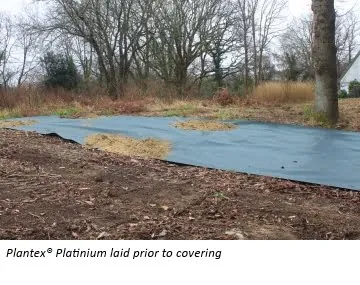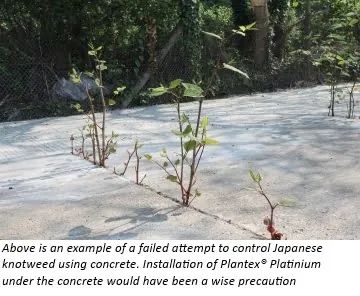There are many methods used to control or eradicate invasive weeds such as Japanese knotweed, all of which have varying levels of efficacy depending upon site conditions.
Tough man-made membranes are often used to supplement these methods to contain knotweed spread in either the vertical or horizontal plane. Vertical membranes have been used successfully in the past when installed underground to prevent spread of knotweed from one parcel of land to another.
Horizontal membranes are also used to suppress weeds. For highly aggressive and destructive weeds such as Japanese knotweed horizontal membranes buried below surface are sometimes used in an attempt to stop any remaining viable knotweed growing to the surface. Examples include locations where it is not possible for technical or economic reasons to remove or kill all of the knotweed crowns and rhizomes, and where a compromise control solution is acceptable. It is of course imperative that a suitable membrane specification is selected.
Membranes that are effective at controlling knotweed tend to be impermeable to water, the rule-of-thumb being that if water can’t get through then neither can knotweed shoots. Installing large impermeable horizontal membranes in the ground creates problems with land drainage.
 DuPont, leaders in membrane innovation, approached Environet UK Ltd in 2017 with their new product “Plantex® Platinium”, a water permeable membrane claimed to control Japanese knotweed without the drainage problems associated with installing impermeable membranes in the ground. Environet tested the product during the 2017 growing season at their research site in Sussex, England. This article summarises the results, and provides guidance to those considering the use of membranes to control Japanese knotweed.
DuPont, leaders in membrane innovation, approached Environet UK Ltd in 2017 with their new product “Plantex® Platinium”, a water permeable membrane claimed to control Japanese knotweed without the drainage problems associated with installing impermeable membranes in the ground. Environet tested the product during the 2017 growing season at their research site in Sussex, England. This article summarises the results, and provides guidance to those considering the use of membranes to control Japanese knotweed. 
During the monitoring period no observations of Japanese knotweed emerging from the area were noted. New growth was however encountered around the periphery. When the membrane was lifted, presence of live crowns and rhizomes were evident, characterised by new white shoots, similar to bean sprouts, and rhizomes with live buds and orange internals when broken.
In some locations the membrane had been damaged, with one small puncture hole approximately 10mm in diameter, and slight delamination and fibre release where the membrane had been stretched. Japanese knotweed had not penetrated the membrane other than in areas where the integrity of the membrane had been compromised. New bean-sprout like growth was evident running horizontally immediately under the membrane.
Discussion
The results indicate that Plantex® Platinium is effective at controlling Japanese knotweed, and backs up the claims of the manufacturer. As is the case with all membranes, they are reliant on their integrity not being compromised, and being installed correctly.
Plantex® Platinium does not kill the root or rhizome system, at least in the short term. Bearing in mind that Japanese knotweed is known to be able to stay alive in a dormant state for at least 20 years, installation of a membrane such as this should be considered to be a method of “control” as opposed to one of “eradication”.
Plantex® Platinium encourages the lateral spread of rhizomes under the barrier. Over a very large area it may be that some of the rhizomes exhaust themselves in their quest for sunlight and subsequently die. However, rhizomes near the edge are likely to emerge at the periphery with new shoots, as was experienced in the field-trial. For this reason we advocate the use of sacrificial zones around the periphery of the membrane, accepting the emergence of Japanese knotweed for subsequent treatment in these areas. We strongly recommend against installing horizontal membrane up to a critical area not considered a sacrificial zone e.g. a neighbouring property/boundary, as the barrier itself will contribute to the spread into the critical area.
The integrity of the membrane is paramount; it should not be put under any undue stress or strain during or after installation, as effective repairs are difficult to make.



